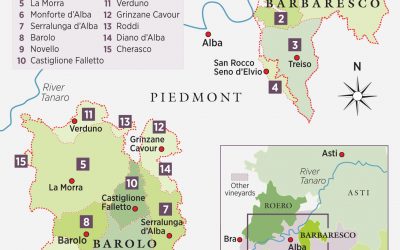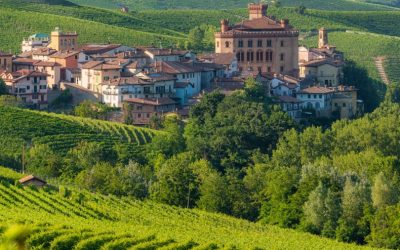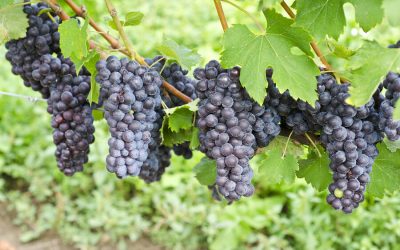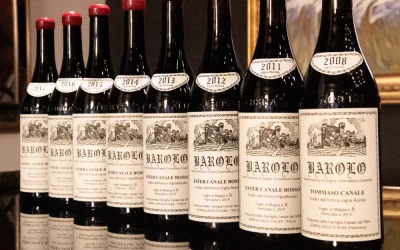Barolo Bussia Cru
The Bussia Cru in the Barolo region of Piedmont, Italy, is recognized for its high-quality Nebbiolo grapes, producing wines with exceptional depth, complexity, and aging potential. The concept of ‘Cru,’ borrowed from the French, signifies a specific vineyard plot known for its superior wine quality due to unique soil and microclimate conditions.
What are the cru in Barolo?
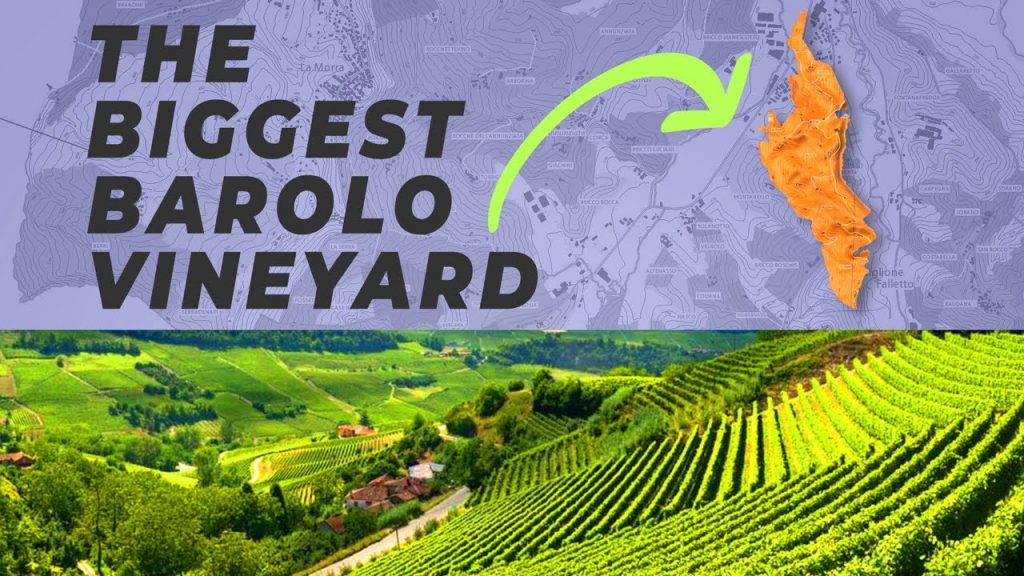
“Cru” is a term that originates from French wine terminology, and in its simplest translation means “growth place”. When we apply this term to the region of Barolo, in Piedmont, Italy, it refers to a specific vineyard or area within Barolo that has a particular reputation for its quality and distinct characteristics. Essentially, each cru has a unique combination of soil, climate, and exposure, which leads to a unique expression of the Nebbiolo grape.
Barolo is divided into eleven communes, of which five (Barolo, La Morra, Monforte D’Alba, Serralunga d’Alba and Castiglione Falletto) are considered the most significant. There are officially 170 individual vineyard areas that have been defined as “Menzioni Geografiche Aggiuntive”, which are equivalent to the concept of Cru. Some of the most renowned Barolo Crus include Cannubi, Rocche di Castiglione, Lazzarito, and Cerequio among others.
Each Cru imparts a different character onto the resulting wine, due to differences in soil composition, altitude, and microclimate. Therefore, a Barolo from the Cannubi Cru might taste noticeably different from a Barolo produced in the Cerequio Cru, despite the fact that both wines are made from 100% Nebbiolo grapes. The concept of Cru is central to the idea of “terroir” – that the land imparts unique characteristics to the wine produced from it.
It’s also important to note that the term “Cru” is used in many wine regions throughout the world, and the specific implementation of this classification can vary significantly from one region to another.
Barolo Bussia Cru
| Barolo Bussia | |
|---|---|
| 🍷 Color | Deep garnet red |
| 👃 Bouquet | Intense scents of spiced rose and licorice |
| 👅 Palate | Dry, warm, full-bodied and balanced with pronounced tannins and a persistent aftertaste |
| 🍴 Pairing | Pairs well with dishes of meat, game and aged cheeses; suitable for many rich international dishes |
| 🌡 Serving Temperature | 17-18º C (62-64º F) |
| 🏞 Vineyard Zone | Village of Monforte d’Alba – Bussia cru |
| 📏 Vineyard Area | 5 hectares |
| 🌤 Exposure | Southwest |
| 🏔 Altitude | About 300 Meters a.s.l |
| 🌱 Soil | Elveziano with clayey and calcareous sediments, rich in iron |
| 🌿 Average Age of Vines | 35 years |
| 🍇 Harvest | In the middle of October |
| 🔢 Grape Yield per Hectare | 70 quintals |
| 🍾 Production | 25,000 bottles a year |
| 🍷 Alcohol Content | Approx. 14-14.5% Vol |
| 🍷 Total Acidity | Approx. 5.3-5.6 g/l |
| 🍇 Cultivation | Traditional methods and a long maceration period; natural fermentation without adding yeast for one month in stainless steel tanks |
| 🍷 Aging | Six months in stainless steel vats and 30 months in Slavonia oak barrels |
Location and Characteristics of Bussia
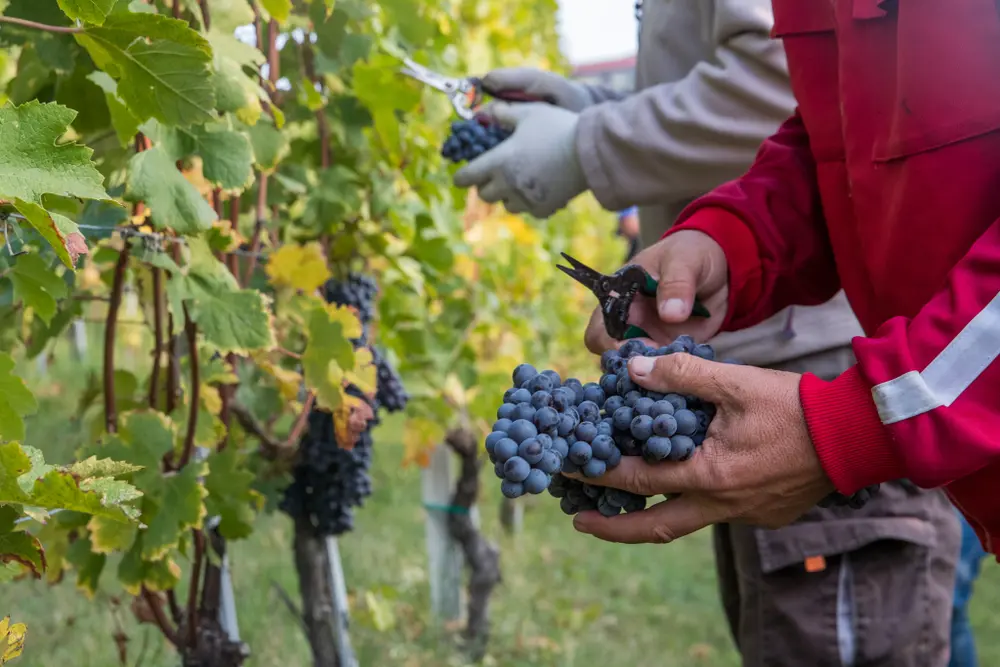
Bussia is located in the commune of Monforte d’Alba, in the southern part of the Barolo appellation. The vineyard’s orientation towards the south and southeast, combined with its altitude of about 300 meters above sea level, provides ideal sun exposure and temperature variations for Nebbiolo grapes to ripen perfectly.
The soil in Bussia is primarily calcareous marl with a high percentage of sand, imparting excellent drainage and forcing the roots of the vines to grow deep into the ground. This soil composition contributes to the development of powerful, structured, and age-worthy wines.
Barolo Bussia Cru Wine Characteristics
The Nebbiolo grapes grown in the Bussia Cru produce Barolo wines that are expressive, full-bodied, and complex. The typical flavor profile includes notes of cherries, dried roses, truffle, and, with aging, elements of tobacco, leather, and spice become prominent. The tannins in Bussia Barolo are firm yet refined, and the wines are known for their exceptional longevity – they can be aged for decades, developing increased complexity and aromatic depth over time.
Barolo Bussia Cru wine Tasting
Barolo Bussia Cru wines, made from Nebbiolo grapes, are among the most prestigious wines in Italy, particularly revered for their complex characteristics and aging potential. Here is a general breakdown of what you might expect when tasting a Barolo Bussia Cru wine:
Visual Assessment
Barolo Bussia Cru wines are typically characterized by a bright garnet color that tends to become more orange and brick-red as the wine ages.
Nose
On the nose, young Barolo Bussia Cru wines offer inviting aromas of fresh red fruits, such as cherries and raspberries, intertwined with floral notes of roses and violets. As the wine ages, the bouquet evolves to reveal more complex aromas, including dried fruit, leather, tobacco, truffles, and even a hint of tar.
Palate
On the palate, Barolo Bussia Cru is known for its robust structure, high acidity, and substantial, yet refined, tannins. These wines are typically full-bodied, with a rich texture and complex flavors mirroring the nose. The finish is usually long, leaving a persistent aftertaste of fruit, spice, and earthy notes.
Aging Potential
Thanks to their structure and tannin content, Barolo Bussia Cru wines have an impressive aging potential. With time, their intense tannins soften, and the wine’s complex aromas and flavors evolve and deepen, providing an even more fascinating tasting experience. They are typically approachable after a decade and can continue to evolve and improve for many more years.
Remember, individual tasting experiences can vary based on the specific vintage, the winemaker’s style, and the wine’s age. For the best tasting experience, serve Barolo Bussia Cru wines at a temperature of around 18°C (64°F) and consider decanting them for a couple of hours before drinking to allow the wine’s complex aromas and flavors to open up.
Barolo Bussia Cru Notable Producers in Bussia
Several esteemed producers have vineyards in the Bussia Cru, contributing to its reputation. Giacomo Fenocchio, renowned for their traditional winemaking methods, produces a Barolo Bussia aged for 36 months in large Slavonian oak barrels, expressing the purest essence of Nebbiolo. Aldo Conterno, another iconic name, makes Granbussia Barolo Riserva characterized by elegance and complexity, with a remarkable aging potential. Prunotto, owned by the Antinori family, is also noteworthy for their Bussia Barolo, exhibiting finesse and balance.
Conclusion
The Bussia Cru in Barolo holds a significant place in the world of wine due to the outstanding quality of its Nebbiolo grapes and the remarkable wines they yield. Wine enthusiasts and collectors worldwide appreciate Bussia Barolo for its depth, power, and longevity, making it a coveted addition to any well-curated wine cellar. Whether enjoyed in its youth or after years of careful aging, a glass of Bussia Barolo promises a memorable tasting experience.
